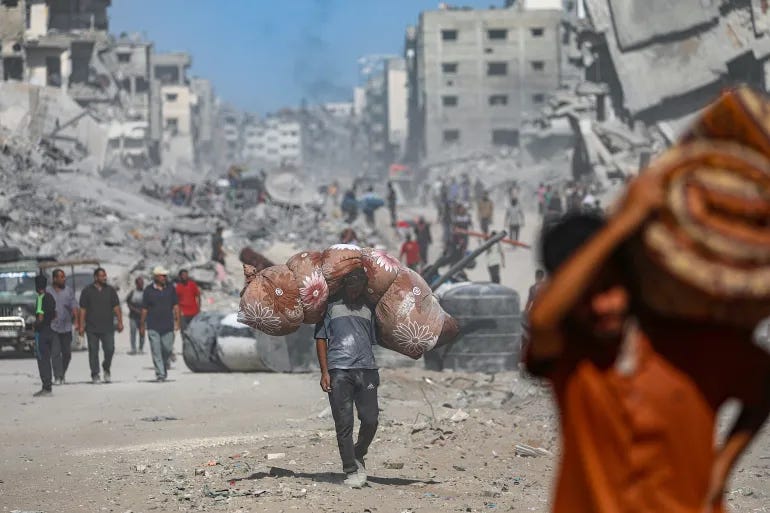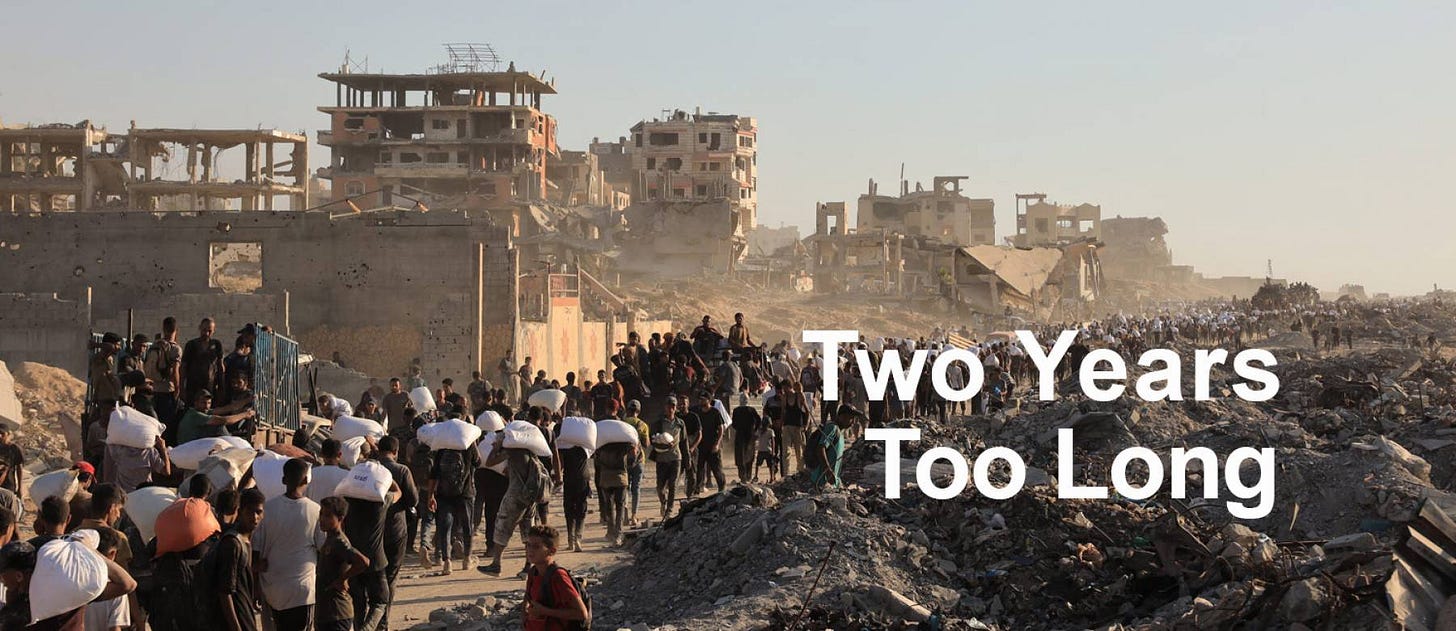From Rubble to Reunions: A Fragile Dawn in Gaza as Trump Heads to the Middle East
As bulldozers clear debris and prisoners prepare for release, Washington’s high-stakes diplomacy shifts to Israel andEgypt — where President Trump hopes to seal a deal that could end two years of war.

Tens of thousands of Palestinians continue to return to their destroyed homes in northern Gaza, where bulldozers have started clearing the mounds of rubble. Meanwhile, Israel has started transferring Palestinian prisoners to two jails before their release under the ceasefire deal with Hamas. Preparations are also under way to receive the Israeli captives who are due to be freed from Gaza. In the occupied West Bank, Israeli forces raided the town of Yatta, south of Hebron. Local sources say a young Palestinian man was wounded by live fire - Al Jazeera
US President Donald Trump is expected to travel to the Middle East to participate in a signing ceremony of the Gaza peace deal in Egypt, potentially marking the end of the two-year bloody Israel-Hamas war, according to media reports. During the trip, Trump is first scheduled to visit Israel on Monday, where a meeting with Prime Minister Benjamin Netanyahu and an address to the Knesset, Israel’s parliament, are planned. The US president’s planned trip to the Middle East follows his announcement early Thursday that Israel and Hamas had agreed to the first phase of a ceasefire agreement in Gaza. The deal was made public following lengthy negotiations in the Egyptian resort city of Sharm el-Sheikh, where Trump’s Middle East envoy Steve Witkoff and son-in-law Jared Kushner, along with mediators from Qatar and Egypt, pushed Israel and Hamas to a ceasefire. Meanwhile, leaders or foreign ministers from Germany, Spain, France, the UK, Italy, Qatar, the UAE, Jordan, Turkey, Saudi Arabia, Pakistan, and Indonesia are expected to participate in the summit in Egypt next week - Euronews
Despite all the jubilation from the Middle East peace deal, mediators still have to secure a longer-term political solution that will see Hamas hand in its weapons and step aside from governing Gaza. In an interview with AFP in Qatar, Hossam Badran, a member of Hamas’s political bureau, warned: “The second phase of the Trump plan, as it is clear from the points themselves, contains many complexities and difficulties.” Hamas, he said, would not attend the formal signing of the Gaza peace deal in Egypt, where international leaders are due to gather Monday to discuss implementing the first phase of the ceasefire. Hamas is resisting calls to disarm. An official from the group, speaking on condition of anonymity, told AFP that it was “out of the question.” Hamas ally Iran also warned it did not trust Israel to respect the ceasefire. “There is absolutely no trust in the Zionist regime,” Foreign Minister Abbas Araghchi, said, accusing Israel of violating previous ceasefires, such as in Lebanon.
A senior Hamas figure, Dr. Basem Naim, said former UK Prime Minister Tony Blair would not be welcome in any role rebuilding or governing the Palestinian enclave. There have been suggestions that the future governance of Gaza could feature Blair, who has been earmarked for a role on an international supervisory body that would administer the enclave during its reconstruction. “When it comes to Tony Blair, unfortunately, we Palestinians, Arabs and Muslims and maybe others around the world have bad memories of him,” Naim said. “We can still remember his role in killing, causing thousands or millions of deaths to innocent civilians in Afghanistan and Iraq. We can still remember him very well after destroying Iraq and Afghanistan.” - Arab News
At least 400 trucks, designated by the Egyptian Red Crescent, and another 100 from UN agencies, and about 50 carrying fuel are expected to arrive in Gaza. The process remains extremely slow, with Israeli inspections delaying convoys at the border. Empty trucks have been seen lining up near the middle area of Gaza, where the aid is expected to enter. Palestinians have been waiting months for humanitarian supplies. Most of Gaza’s population depends entirely on this aid. People are not waiting only for food, but also for tents, mobile shelters, solar panels and desperately needed medical equipment and medicines – items largely unavailable for the past two years. Residents say they have been deprived of even the most basic necessities. Queues for clean water and food stretch through neighbourhoods, as people hold pots and containers hoping for supplies. Some signs of normal life are slowly returning. A few bakeries have reopened, and small markets are beginning to operate again. But Gaza’s economy remains shattered, most people have lost their savings, have no access to bank accounts, and are completely dependent on humanitarian aid to survive - Al Jazeera
“When it comes to (former UK Prime Minister) Tony Blair, unfortunately, we Palestinians, Arabs and Muslims and maybe others around the world have bad memories of him. We can still remember his role in killing, causing thousands or millions of deaths to innocent civilians in Afghanistan and Iraq. We can still remember him very well after destroying Iraq and Afghanistan” - senior Hamas figure, Dr. Basem Naim

Beijing imposed new penalties on US-linked ships, the latest in a growing list of retributive measures against Washington over restrictions targeting China’s economy. The additional fees come into effect next week, and mirror US charges on Chinese ships docking at American ports, an effort by the Trump administration to bolster domestic shipbuilding and counter Beijing’s growing dominance of global shipping. They come days after Beijing unveiled its own version of Washington’s “foreign direct product rule,” requiring those who buy rare earths from China to get Beijing’s approval before selling them — or products containing them — on to third parties. “This raises the risk of further disruptions for… global business more broadly,” analysts at the China-focused research firm Trivium warned - Semafor
🎥 From On the Ground: Ukraine’s War Enters a New Phase
In this exclusive excerpt from World Briefing Plus, I break down what’s really happening behind the headlines — from Russia’s intensifying strikes on critical infrastructure to Ukraine’s shifting strategy as winter looms.
This is just a glimpse of the in-depth analysis, context, and insider insights I share each week with my paid subscribers.
If you’ve been finding value in World Briefing, now’s the perfect time to upgrade to a paid subscription — and get full access to all my exclusive videos, hot takes, and behind-the-scenes reporting from the world’s crisis zones.
👉 Subscribe now and join the conversation beyond the headlines.
With more drones in its arsenal and advances in missile-targeting technology, Russia may be striving to make this winter the worst for Ukrainians since it launched the full-scale invasion in February 2022. One ominous sign is a change in Moscow’s strategy: This year, it has made Ukrainian natural gas infrastructure a far more frequent target than it had in the past. The October 3 attack that hit assets of state-owned Naftogaz in the Kharkiv and Poltava regions was the largest strike on gas facilities to date, the company’s CEO said. It came weeks before the heating season begins later this month. “It was yet another display of Russian malice, aimed solely at disrupting the heating season and depriving Ukrainians of the ability to heat their homes this winter, “ Serhiy Koretskiy said in a statement. The attack damaged “a significant portion of our facilities,” he said, adding, “Some of the destruction is critical.” Naftogaz produced 13.9 billion cubic meters (bcm) of natural gas last year, accounting for almost three-quarters of total Ukrainian output. Russia followed the October strike with additional attacks on Naftogaz facilities on October 5, then hit a major power plant two days later. In the first three years of the war, Russia concentrated on crippling Ukraine’s electric power grid. But since the contract to ship Russian gas to Europe via Ukrainian pipelines ended on January 1, Moscow has turned its attention to Ukraine’s gas production and storage capabilities. Naftogaz infrastructure has been struck more than 100 times in at least 11 separate air assaults in 2025. Those attacks account for half of all strikes on the company since the full-scale invasion began in 2022. Meanwhile, the Ukrainian power sector, which suffered 13 massive attacks in 2024 that knocked out 9 gigawatts of power generation capacity -- the equivalent of half of peak winter demand -- is still very much on the Kremlin’s radar. Overnight strikes on October 9-10 severely damaged equipment at thermal power stations belonging to DTEK, Ukraine’s largest private energy company, and marked the third time its facilities were attacked in a week, the company said. It said its thermal power stations have been attacked more than 200 times since the start of the full-scale invasion. The October 10 strikes on Kyiv notwithstanding, Moscow has recently been targeting mainly energy facilities in regions closer to Russia, such as the border regions of Sumy and Kharkiv in the northeast - RFE/RL




